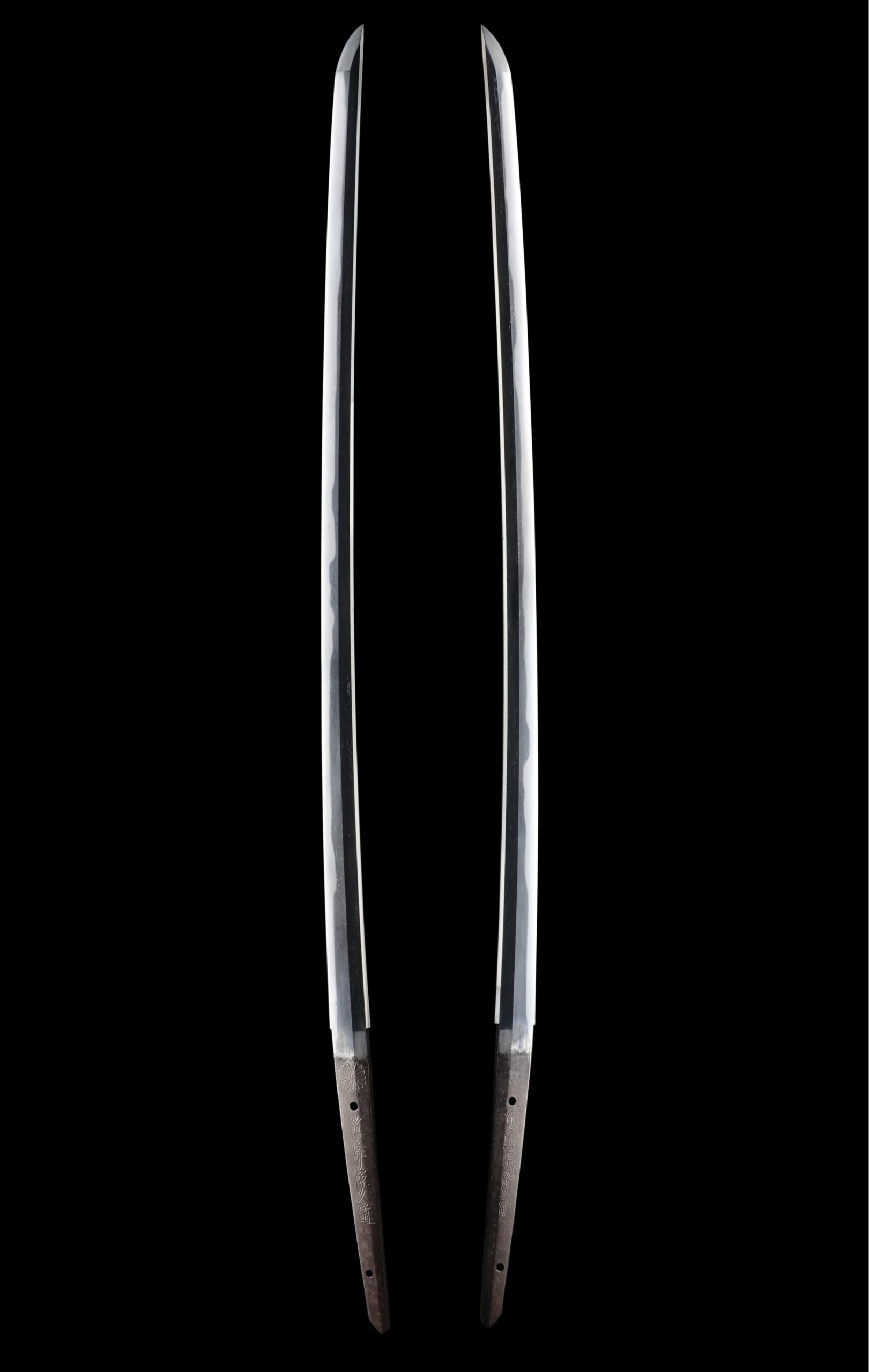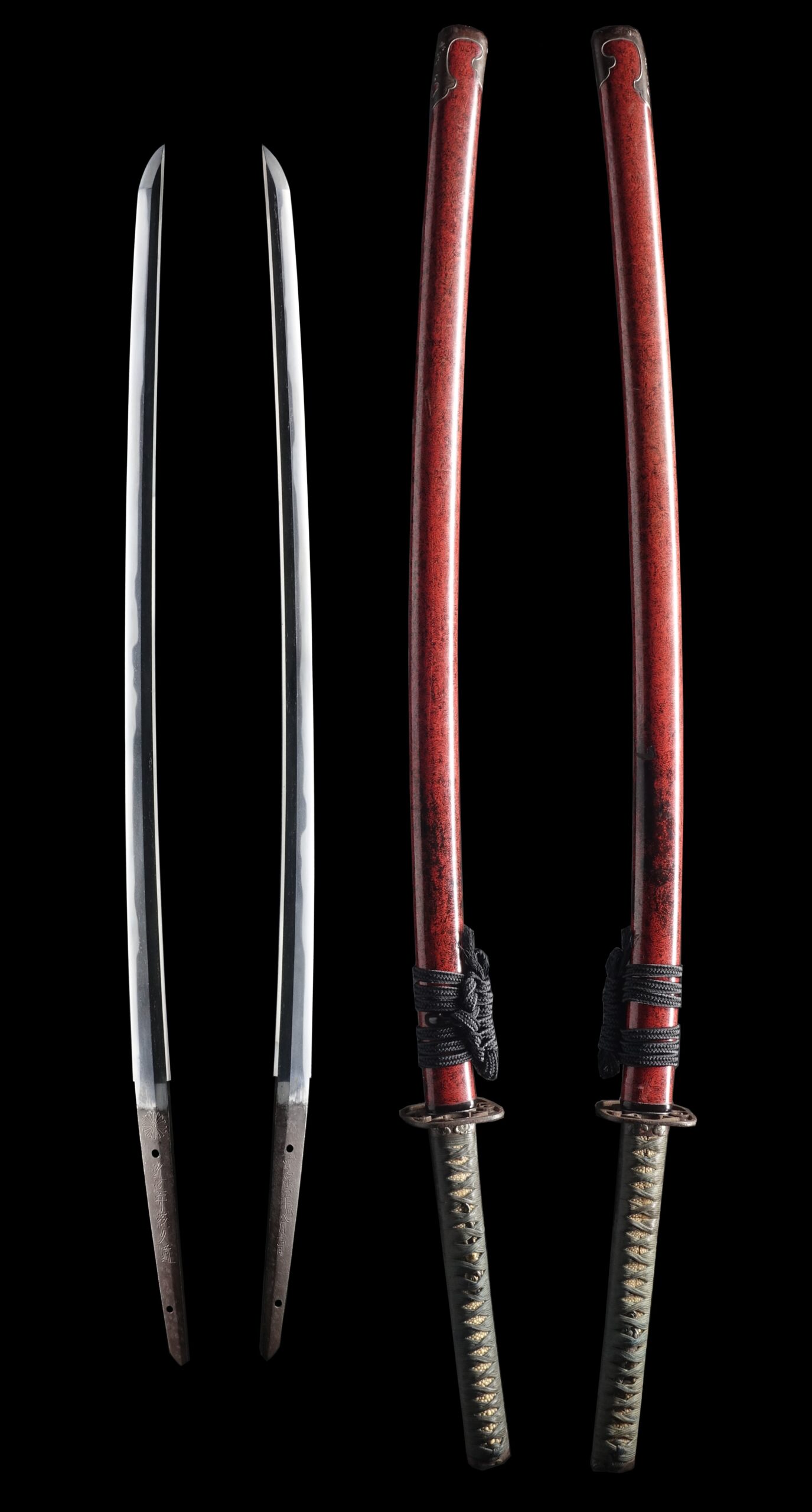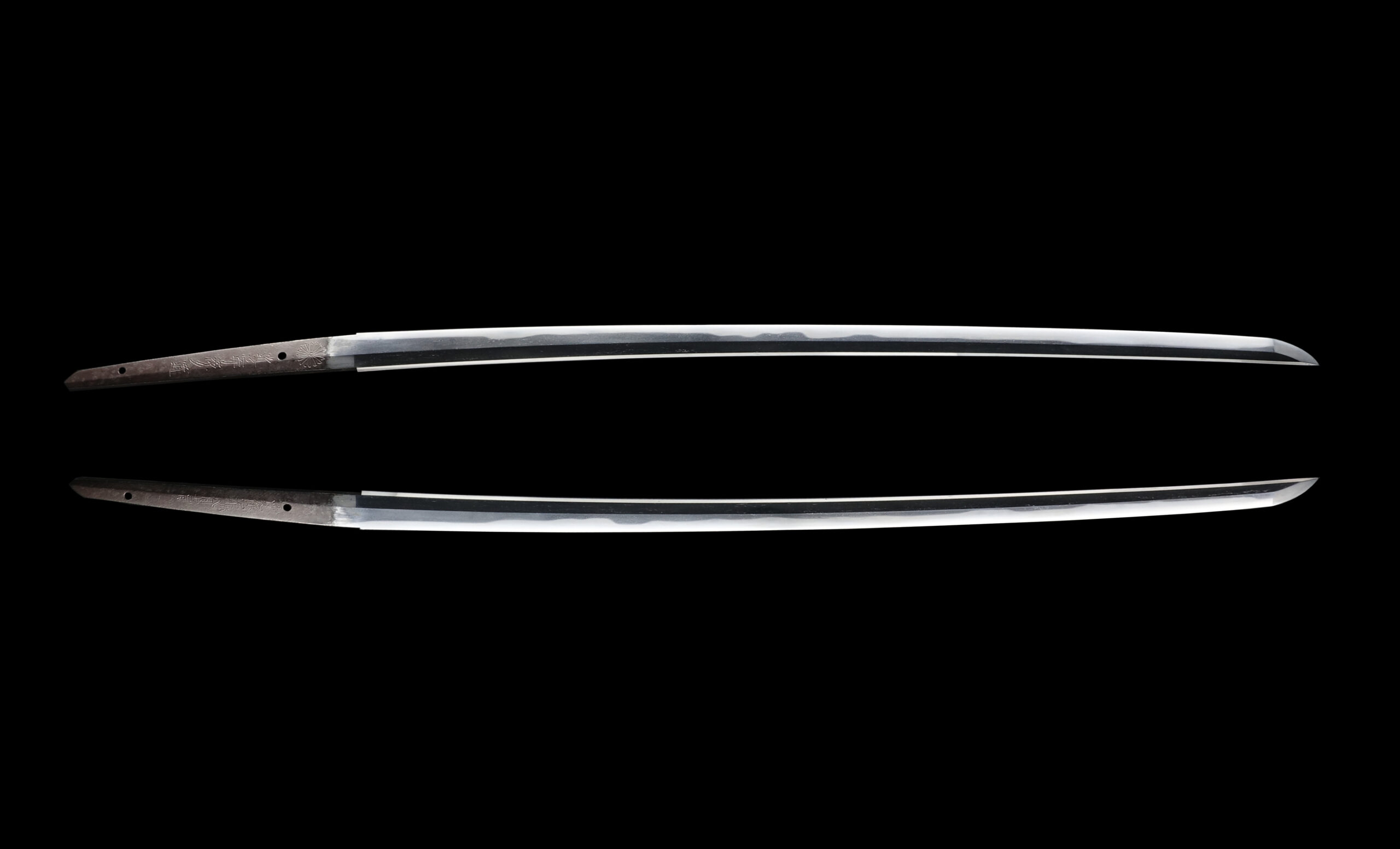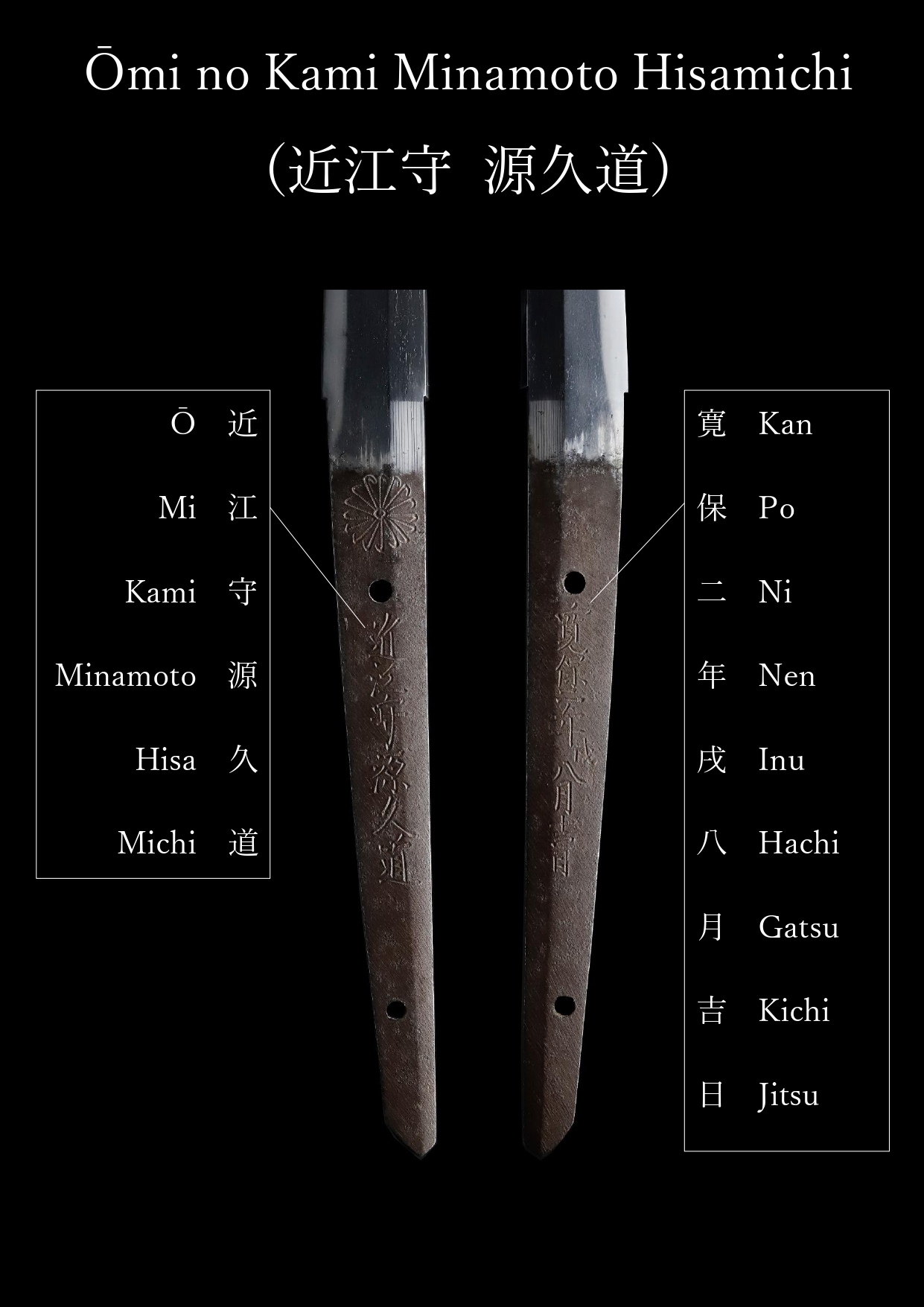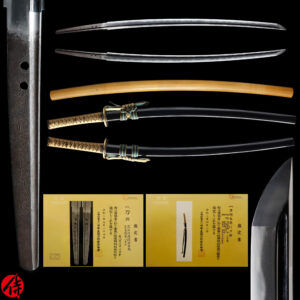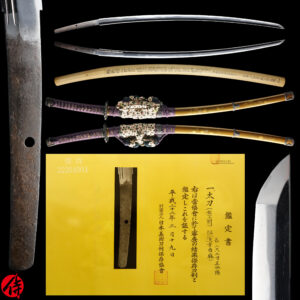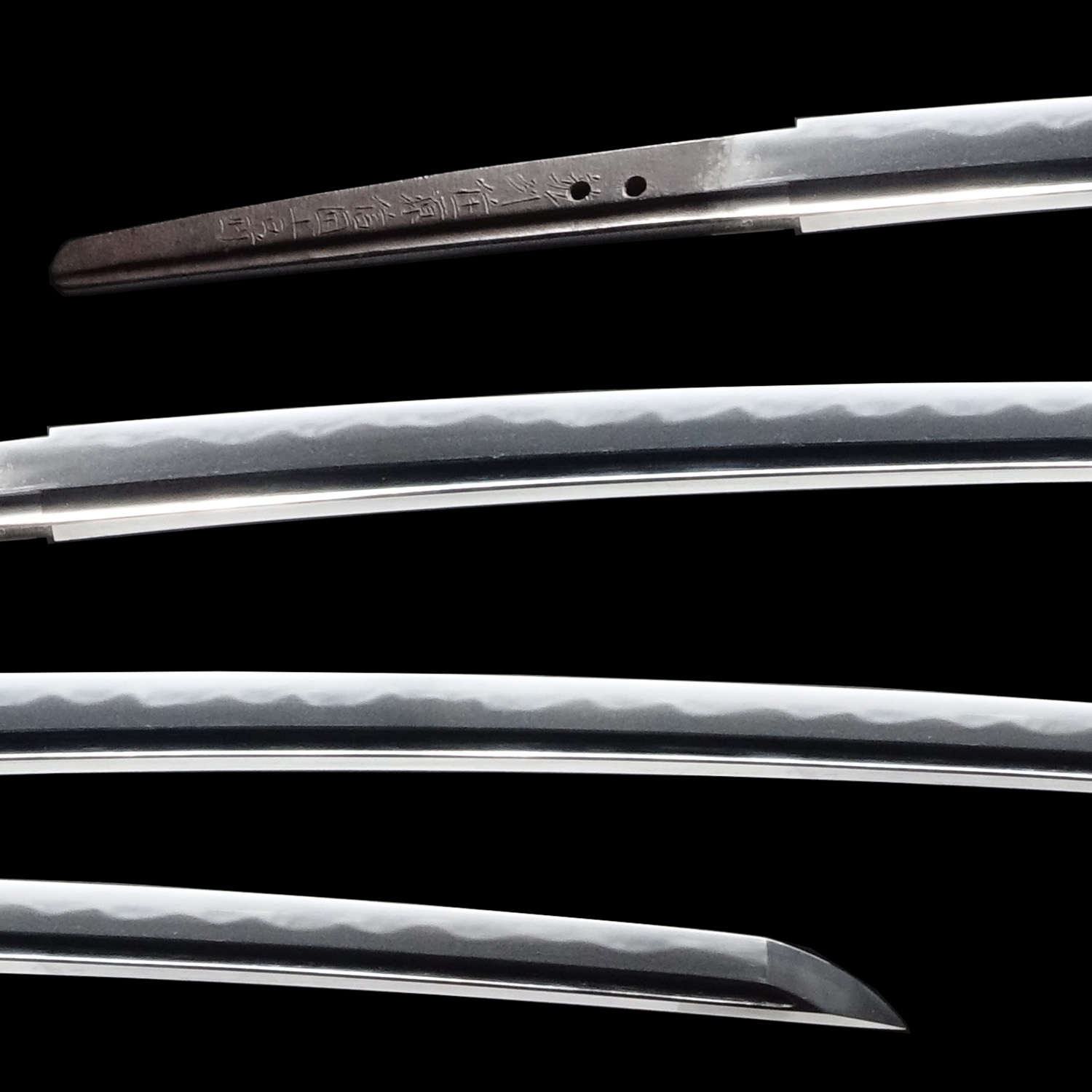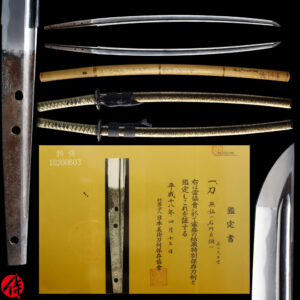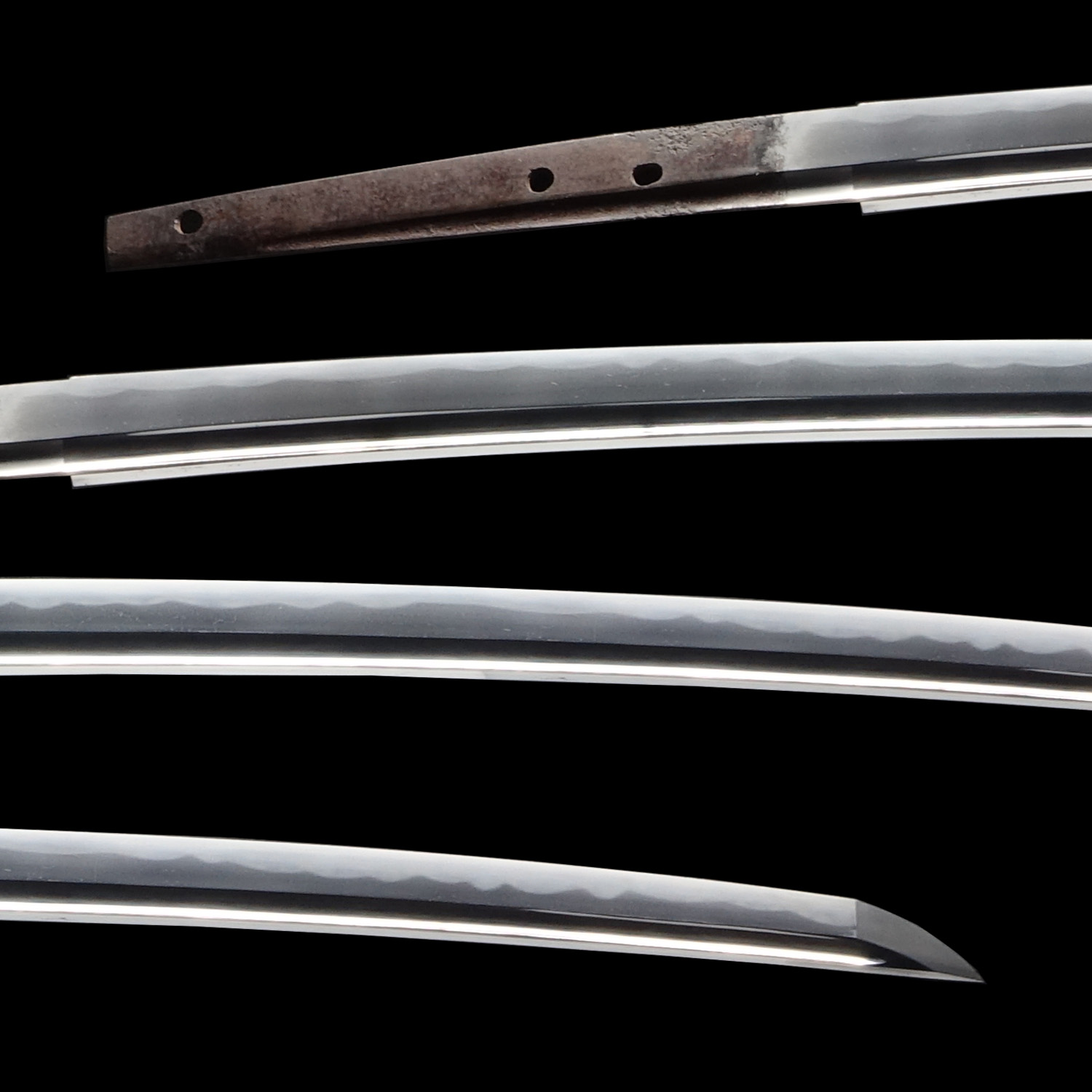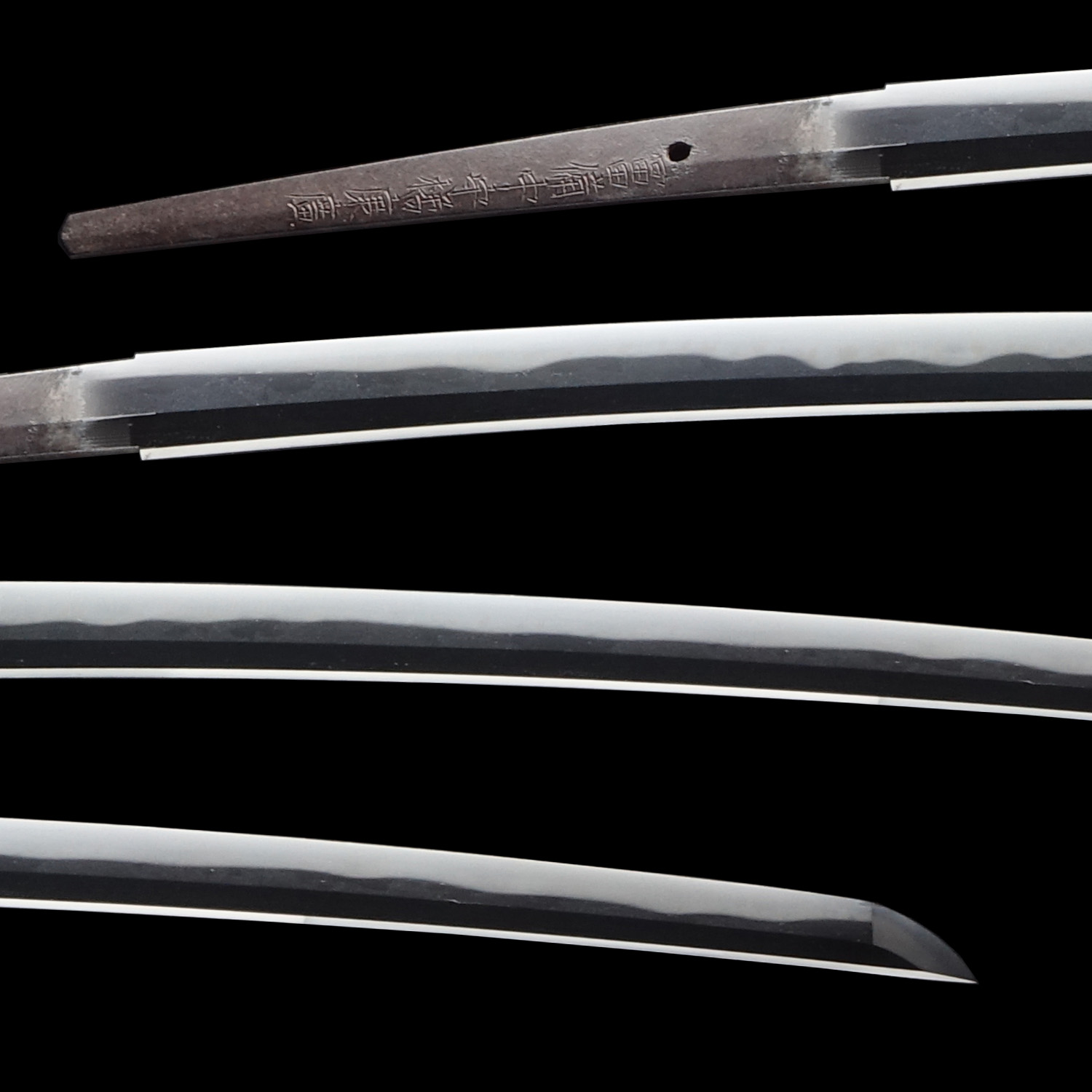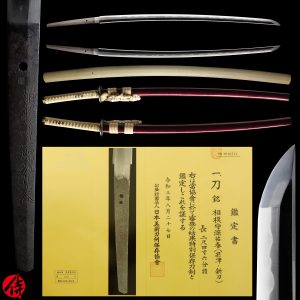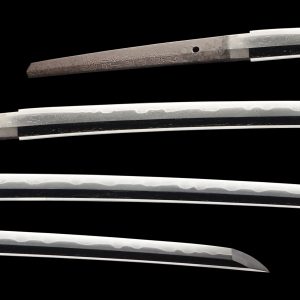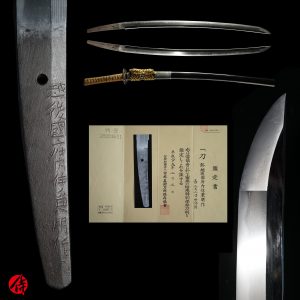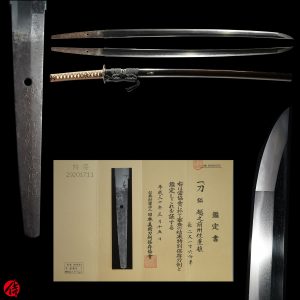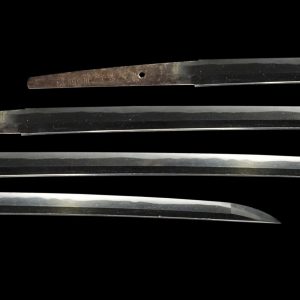Antique Japanese Sword Katana Signed by third-gen Hisamichi with Tokubetsu Hozon Certificate
【Description】
This blade was signed by Omi no Kami Minamoto Hisamichi (近江守源久道) in August, the second year of the Kanpou era (1742). Judging from the year inscribed on the tang, we believed it was made by the third-gen Hisamichi. The swordsmith’s name Hisamichi lasted seventh generations. The third generation was especially active during the early-mid Edo period (1716-1748).
The first-gen Hisamichi, his father, was born in the second year of the Kan-Ei era (1625) in Omi province (Shiga prefecture). He belonged to Mishina school, a prestigious school in Yamashiro province(today’s Kyoto prefecture). He studied sword forging techniques under the master, the second-gen Iganokami Kinmichi (伊賀守金道), one of the most famous swordsmiths in Yamashiro province during the early Edo period.
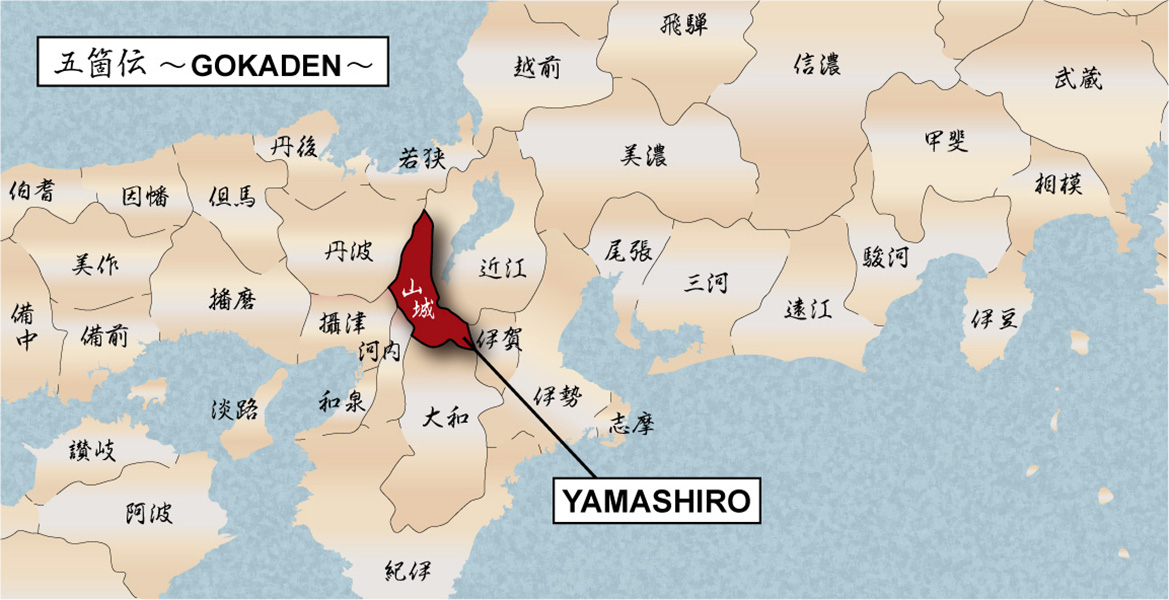
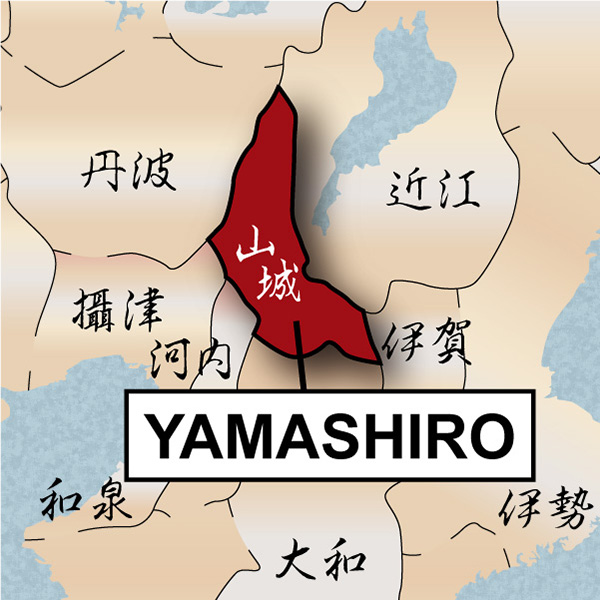
The first-gen Hisamichi received the honorable title of Omi No Kami(近江守) in 1662 when he was 37 years old. The imperial court back then gave the title of Kami to those who were excellent at sword making. After receiving this title, the swordsmith added it to his maker’s name when he signed his swords, such as Omino Kami Hisamichi. The first-gen Hisamichi was also known as one of Gokaji. (five most prestigious swordsmiths in Kyoto). He was allowed to inscribe a chrysanthemum emblem, which is the symbol of the Japanese emperor. His sword forging technique was so great that the emperor permitted him to use this emblem, which was honorable for any swordsmith. The sword forged by him were also famous for their sharpness. He passed his excellent craftsmanship to the second-gen Hisamichi. And, he died at the age of 86 in 1711.
The second Hisamichi was born in the third year of the Kanbun era (1663) as the son of the second-gen Rai Kimichi, who also belonged to Mishina school. He originally signed Hisatsugu (久次). He was eventually adopted by the first-gen Hisamichi and changed his maker’s name to Hisamichi. In the 15th year of the Genroku era, he received Omi no Kami title like his father. In the 7th year of the Kyoho era, the second-gen Hisamichi was ordered to stay in Edo City (Today’s Tokyo) to forge swords.
The third-generation Hisamichi was born as the second son of the second-generation Hisamichi. The third-gen was ordered to visit Edo City by Tokugawa Yoshimune, the 8th-gen Shogun of Tokugawa Shogunate. He forged Utsushi of Konotegashiwa and Wakasa Masamune for Yoshimune. It is said that Yoshimune was pleased by the Utushi created by the third-generation Hisamichi. This fact indicates that the Edo government highly acknowledged his craftsmanship. The third-gen Hisamichi was also allowed to inscribe chrysanthemum emblem on the tang.
During the Edo period, it was popular among high-class feudal lords to have an authentic Japanese sword made by renowned swordsmiths based on historically famous swords, such as Wakasa Masamune. This kind of work is called Utsushi. Since the fourth generation, Hisamichi served Date clan in Iyo province and lasted until the early Meiji period.
It is appraised as a Tokubetsu Hozon Touken (特別保存刀剣) issued by NBTHK (Nihon Bijutsu Touken Hozon Kyokai: 日本美術刀剣保存協会). This authentication paper was only given to authentic Japanese swords, especially well preserved and high quality with artistic value.
【 Blade】
Cutting Edge Length (Nagasa): 76.1 cm (30.0 inches)
Curvature (Sori): 1.0 cm (0.39 inches)


Hamon:
the crystalline structure which forms along the cutting edge of a blade as a result of the hardening process
Jimon(Jihada):
visible steel surface pattern created by folding and hammering during forging process
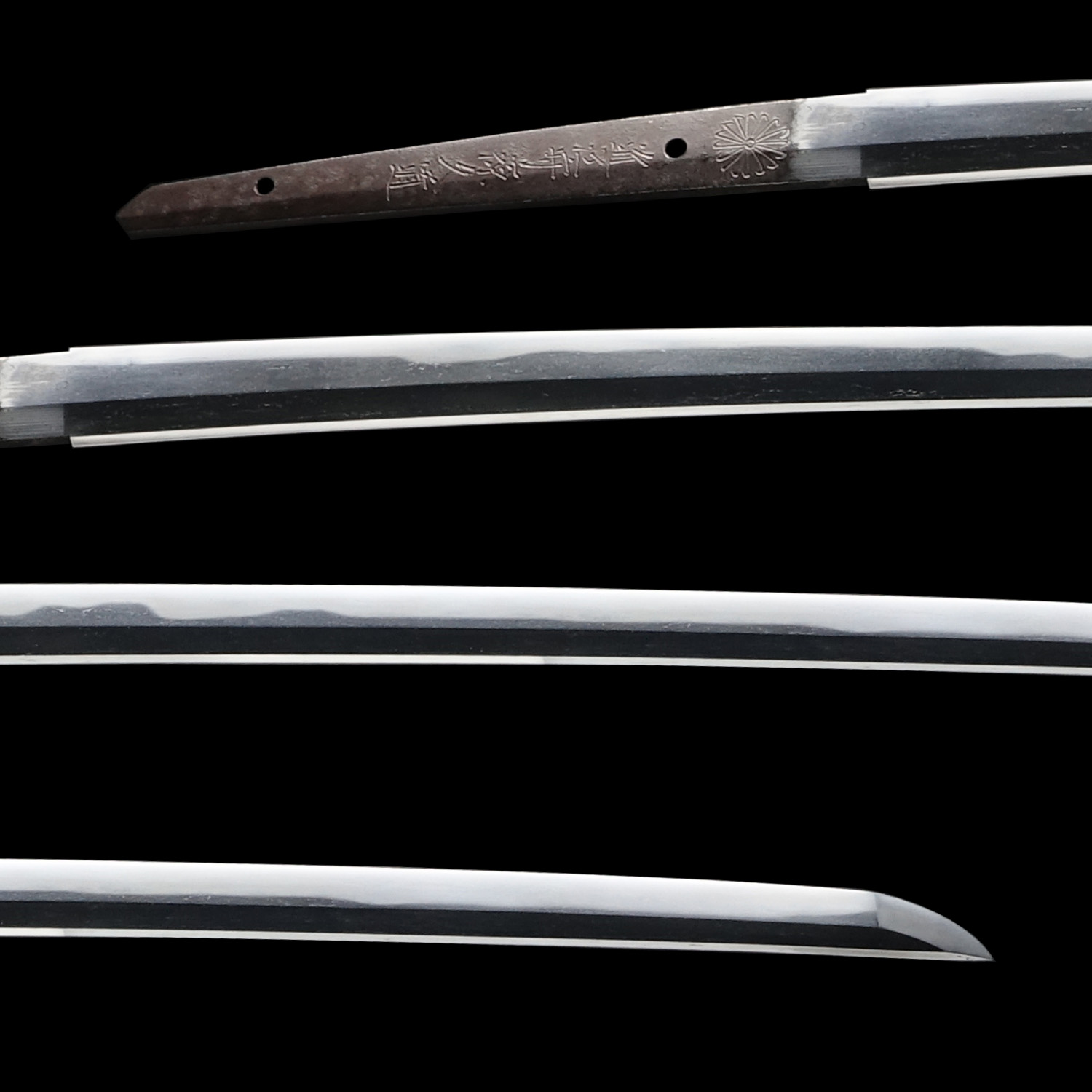
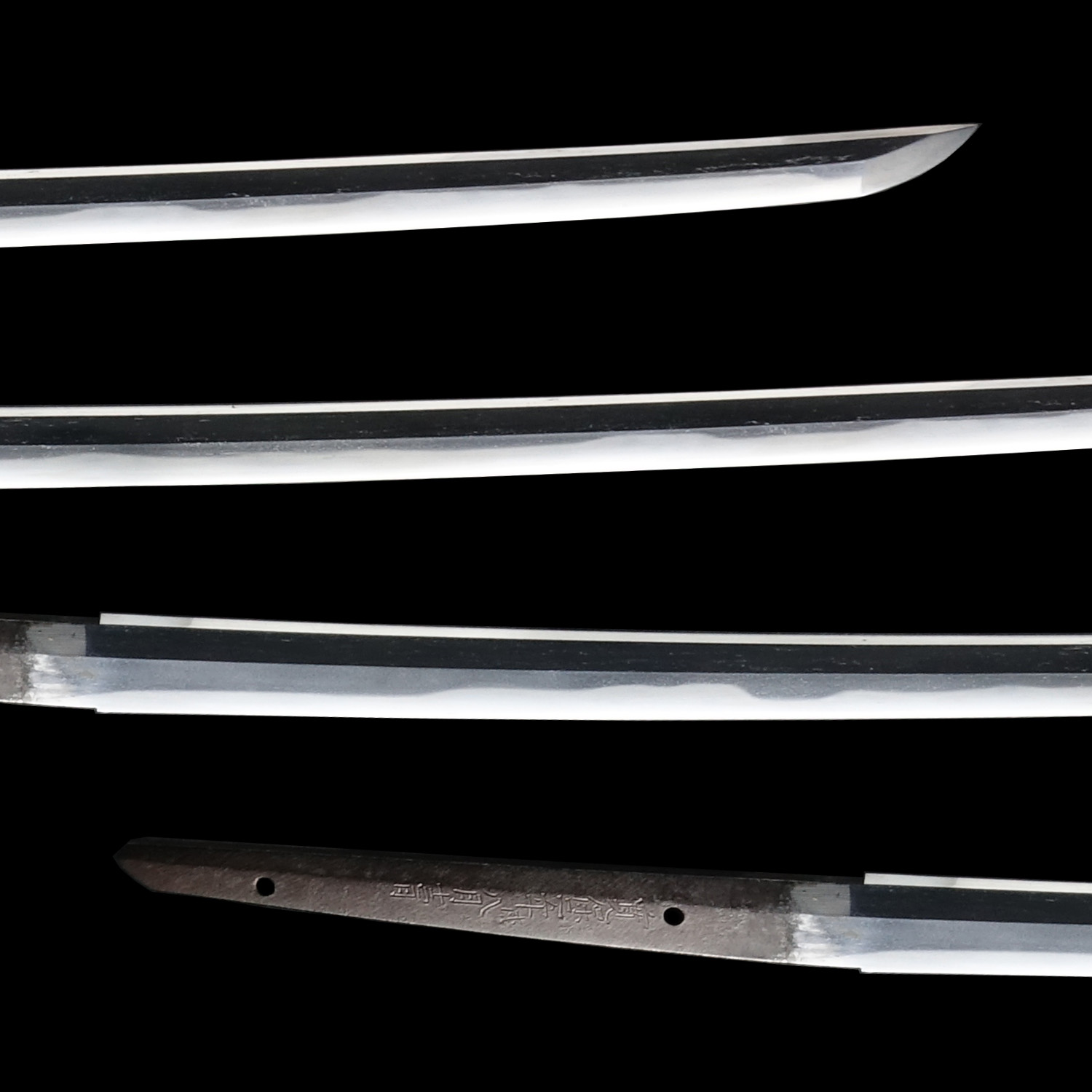

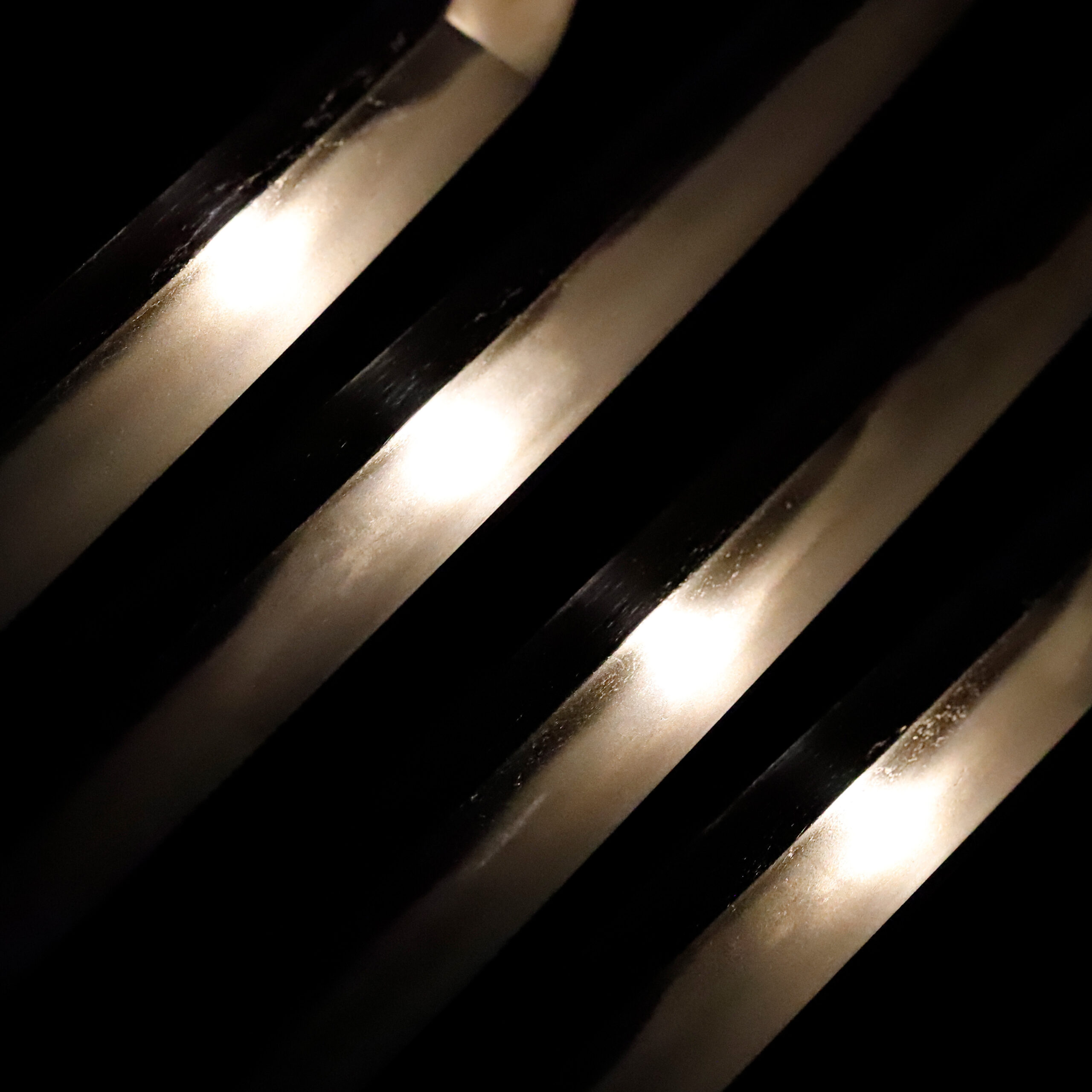
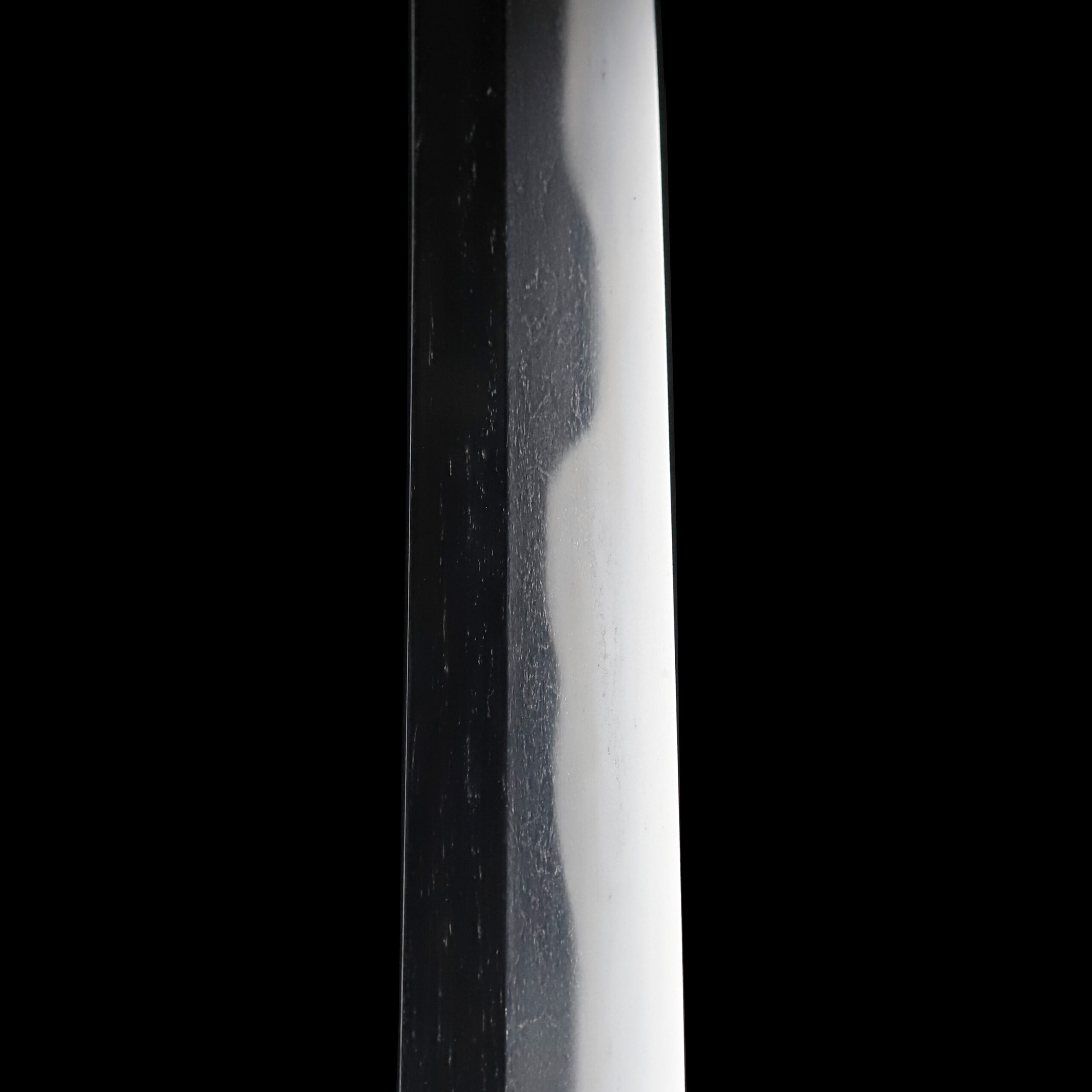
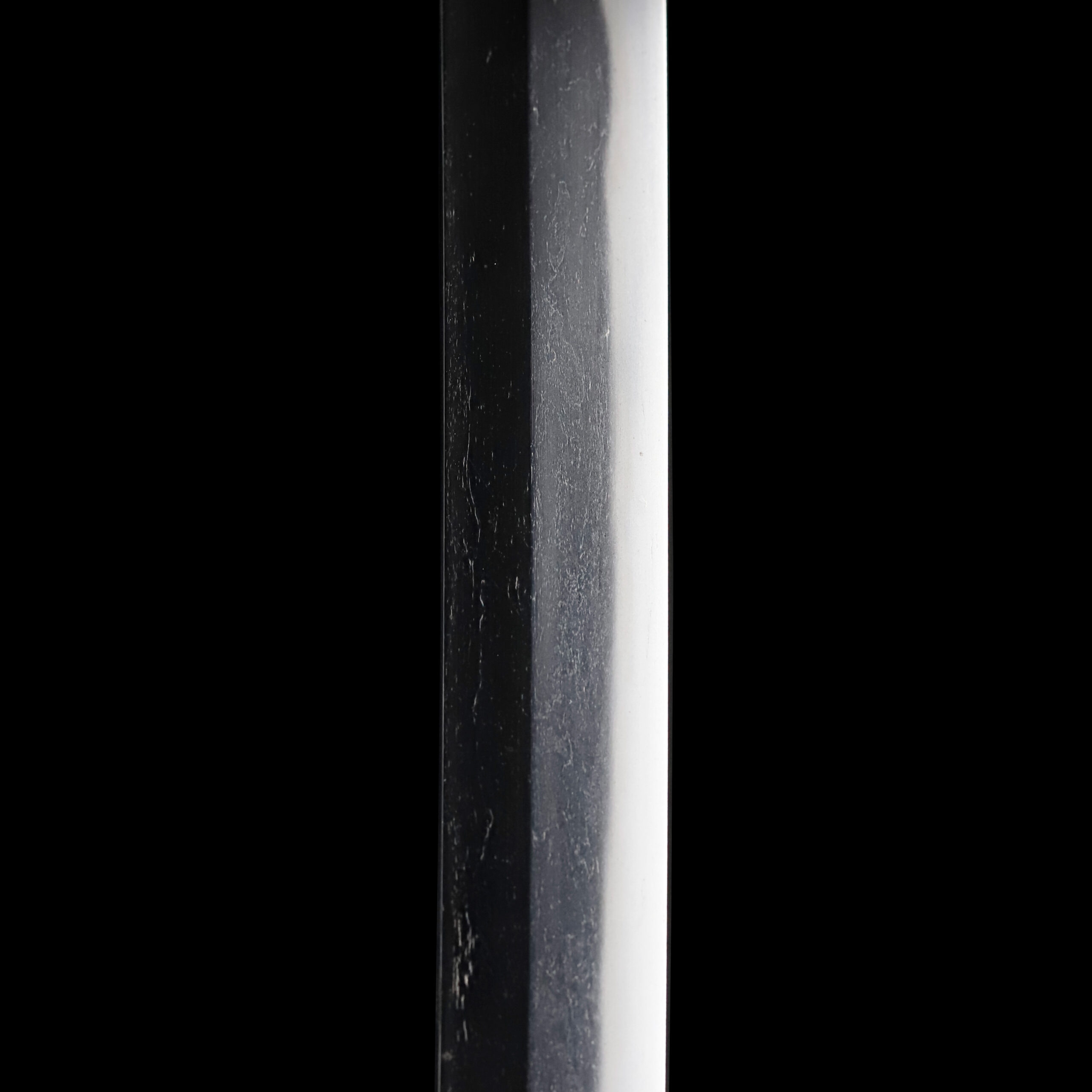
Nakago: Nakago is the tang of the Japanese sword.
Japanese swordsmiths left the black rust on the tang because it prevents red rust while the tang is in its handle. And the discoloration of the tang was created over time, and it is a great indicator for a Japanese sword specialist to estimate when the sword was forged.

Koshirae: Koshirae is the mounting of the Japanese sword. There are several parts that consist of Koshirae such as Saya (Scabbard), Tsuka (Handle), Tsuba (Handguard).
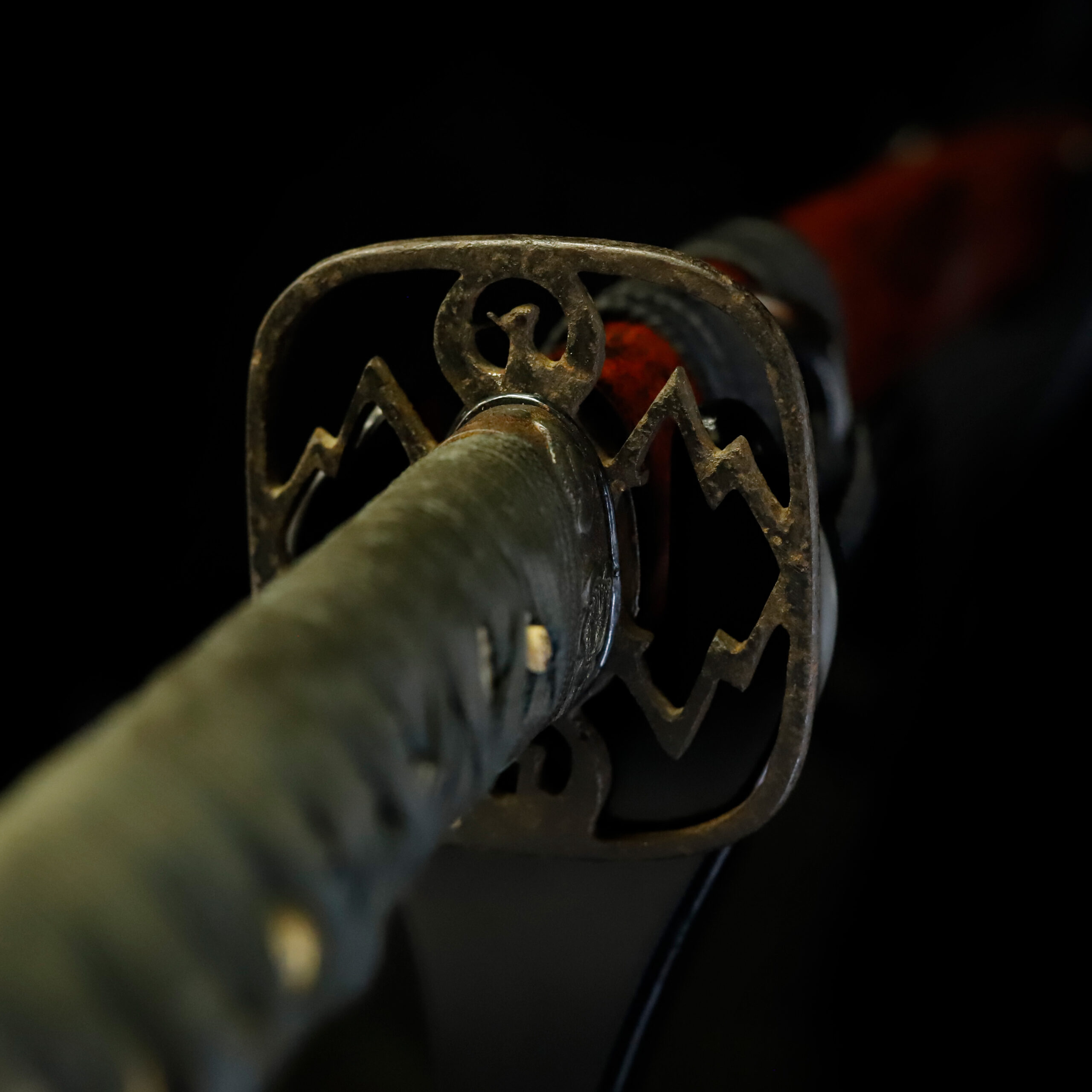
Fuchi-Kashira: A pair of matching sword fittings that cover the upper and bottom parts of its sword hilt.
The Ume (梅, Japanese apricot blossom) patterns are engraved on this Fuchi Kashira. Japanese apricot blossoms begin to bloom in winter when snow still covers its tree, so people think this flower tells the arrival of spring. This plant has been appreciated for a long time in Japan. People enjoy its adorable petal shape and scent and gracefully branched tree and compose many poems. As it comes out in the cold season, it symbolizes the power of perseverance and vitality.
This Koshirae’s scabbard is decorated with flower motifs. If you focus on the Kojiri (鐺, the metal fitting that protects the tip of a scabbard), Sakuras (桜, cherry blossom) are designed. Silvery paint is applied to these flowers. One theory says that the god of grain exists in cherry blossoms. Therefore, this flower pattern has been treated as the symbol of a plentiful harvest.

Tsuka and Menuki: Tsuka is the handle of the Japanese sword and Menuki is its decoration.
It seems a Tora (虎/寅, tiger) is the model of each Menuki. Golden paint is applied to here and there, and this coloring adds decorativeness to this work. As the saying goes, “A tiger travels a thousand miles in a day and returns a thousand miles.” It is said that with its strong vitality shakes off all kinds of disasters and leads to prosperous family fortunes. In addition, the tiger facing forward is said to be a “tiger of all directions.” It is drawn as if it is glaring at a foreign enemy to prevent disaster from approaching, and it has the meaning of an amulet and exorcism.
This animal is known as a member of the Junishi (十二支, the twelve signs of the Chinese and Japanese zodiac). There are various theories about the details of the Junishi legend. Its rough outline is that the twelfth animals that arrived early at the feast that god held on New Year’s Day were nominated as the representatives for the year. Each animal has a rustic meaning, and the Junishi itself has been treated as a lucky charm in Japan. It is said that the devotion of people who believed in the mysterious power of animals was linked to the Junishi, and the custom of welcoming the god of the year by decorating animal figurines associated with the twelve zodiac signs of the year in the entrance or living room was born.
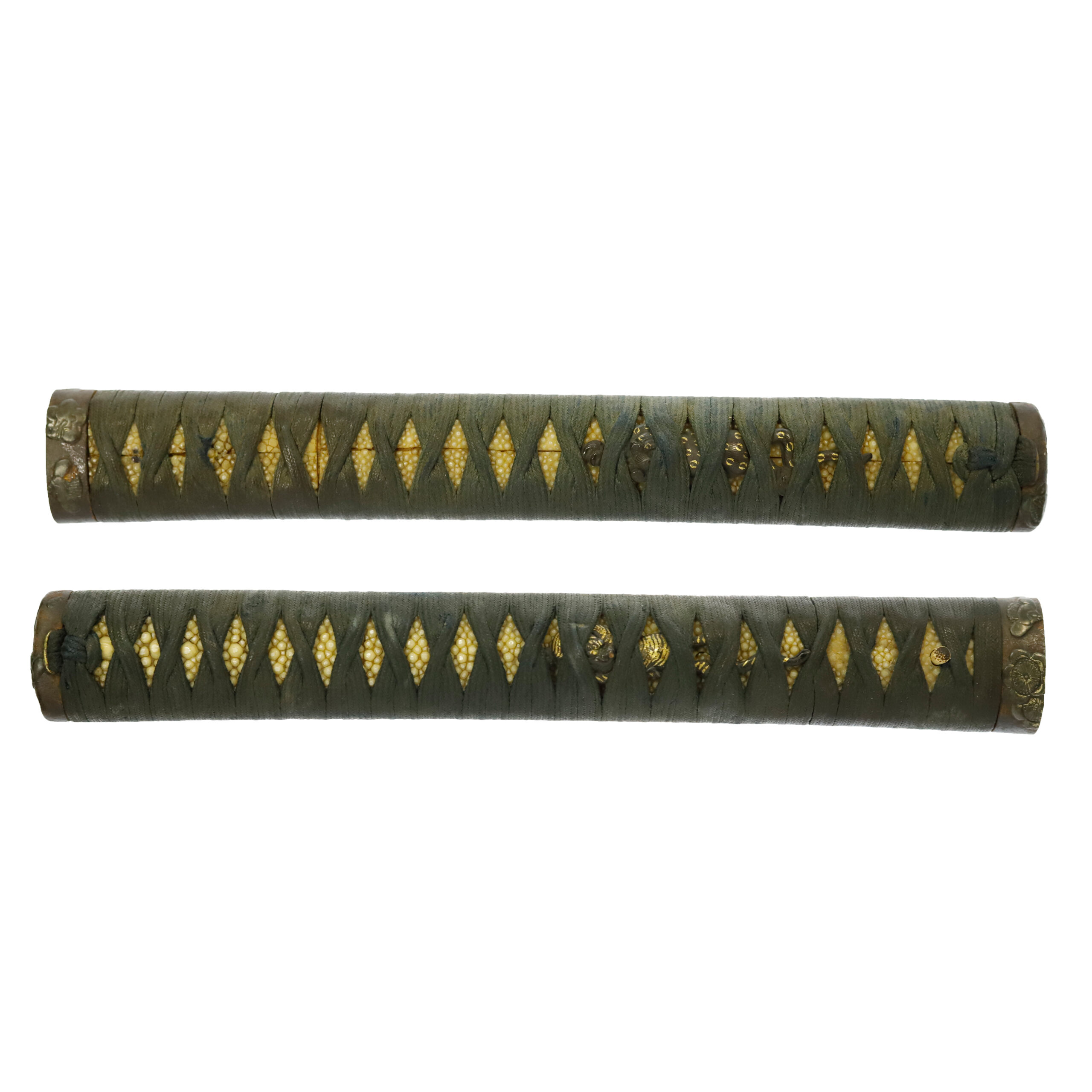
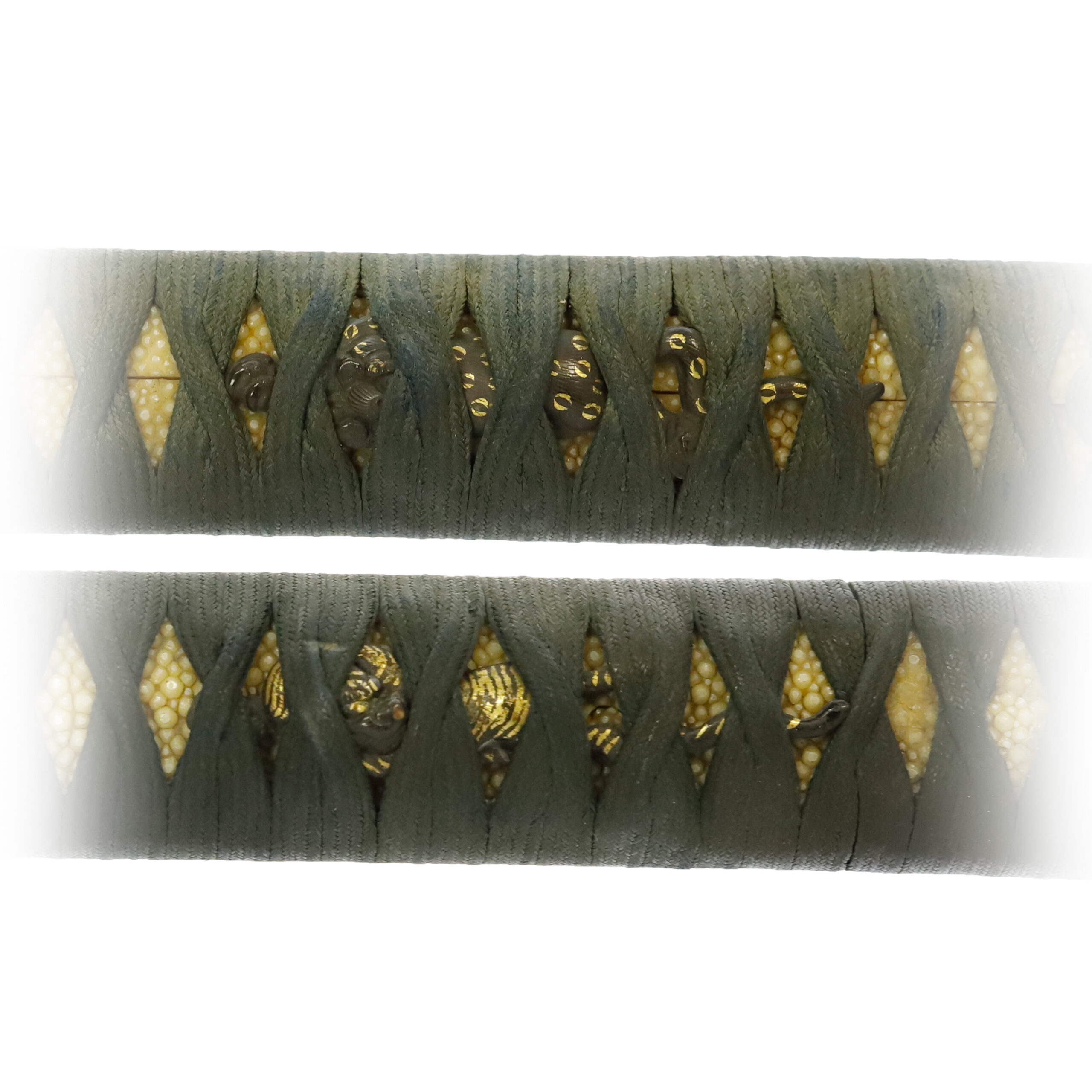
Tsuba and Habaki: Tsuba is the handguard for the Japanese Sword and Habaki is the equipment to make the blade not touch its scabbard inside. It prevents the blade from getting rusty and chipped.
This Tsuba’s design is composed of two crests. One is the Matsukawabishi (松皮菱/松川菱) pattern, and the other is the Tsurunomaru (鶴の丸) pattern. The Matsukawabishi design is a geometric pattern inspired by the bark of a pine tree. The design resembles a diamond with small diamonds added above and below it. The pine tree has been regarded as an auspicious symbol of longevity as hermits with divine powers lived in pine tree-made houses and ate pine trees. It is said that the pine bark rhombus was used in family crests to protect against evil spirits.
About the Tsurunomaru pattern, its model is a Tsuru (鶴, crane). There is a proverb that says that cranes and turtles live a long life. It says cranes have even one thousand years lifespan. Therefore, cranes and turtles have been considered symbols of longevity for a long time. In this way, such good-luck animal and plant motifs were incorporated into this Tsuba’s design.
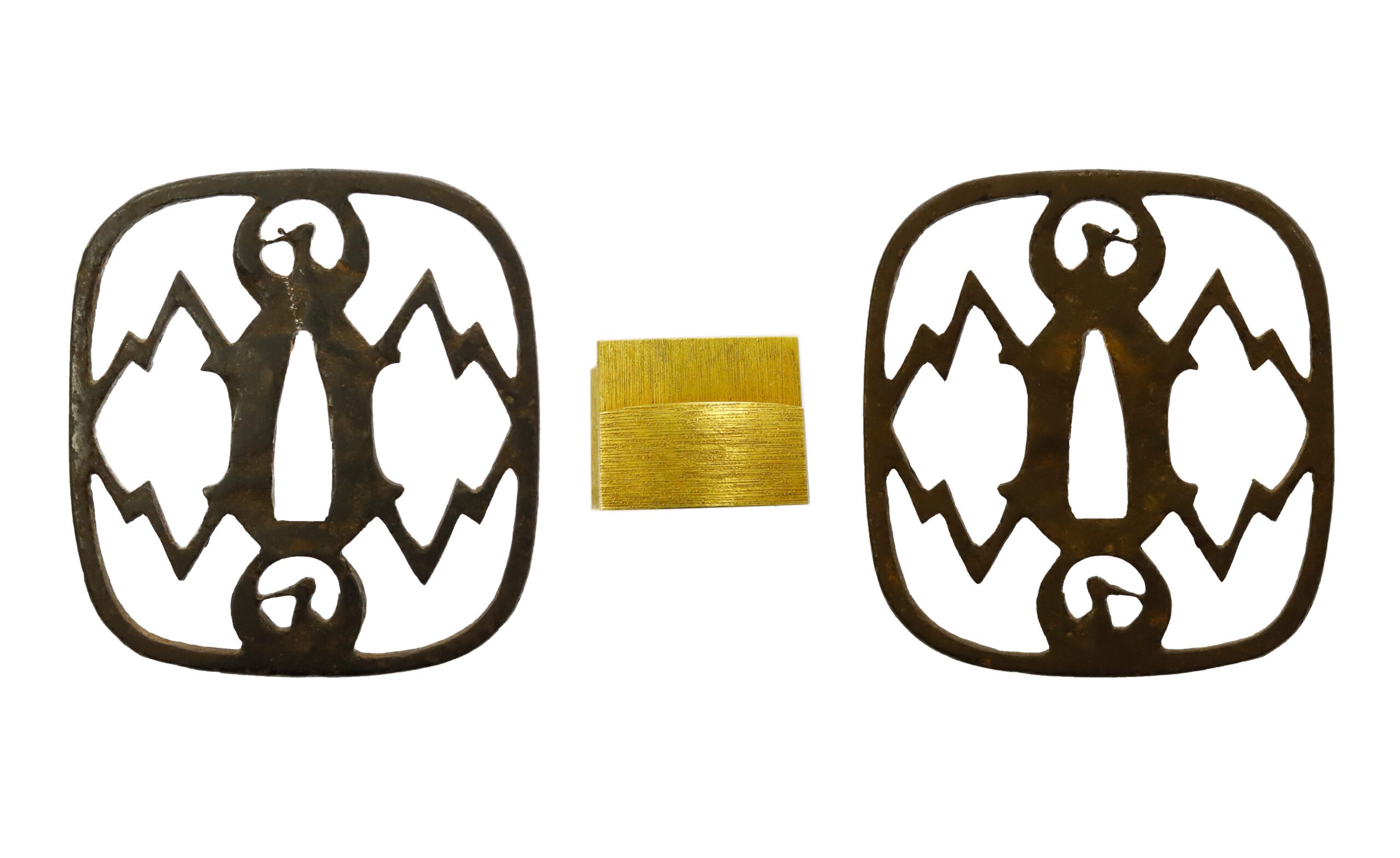
Saya: Saya is the scabbard for the Japanese sword.
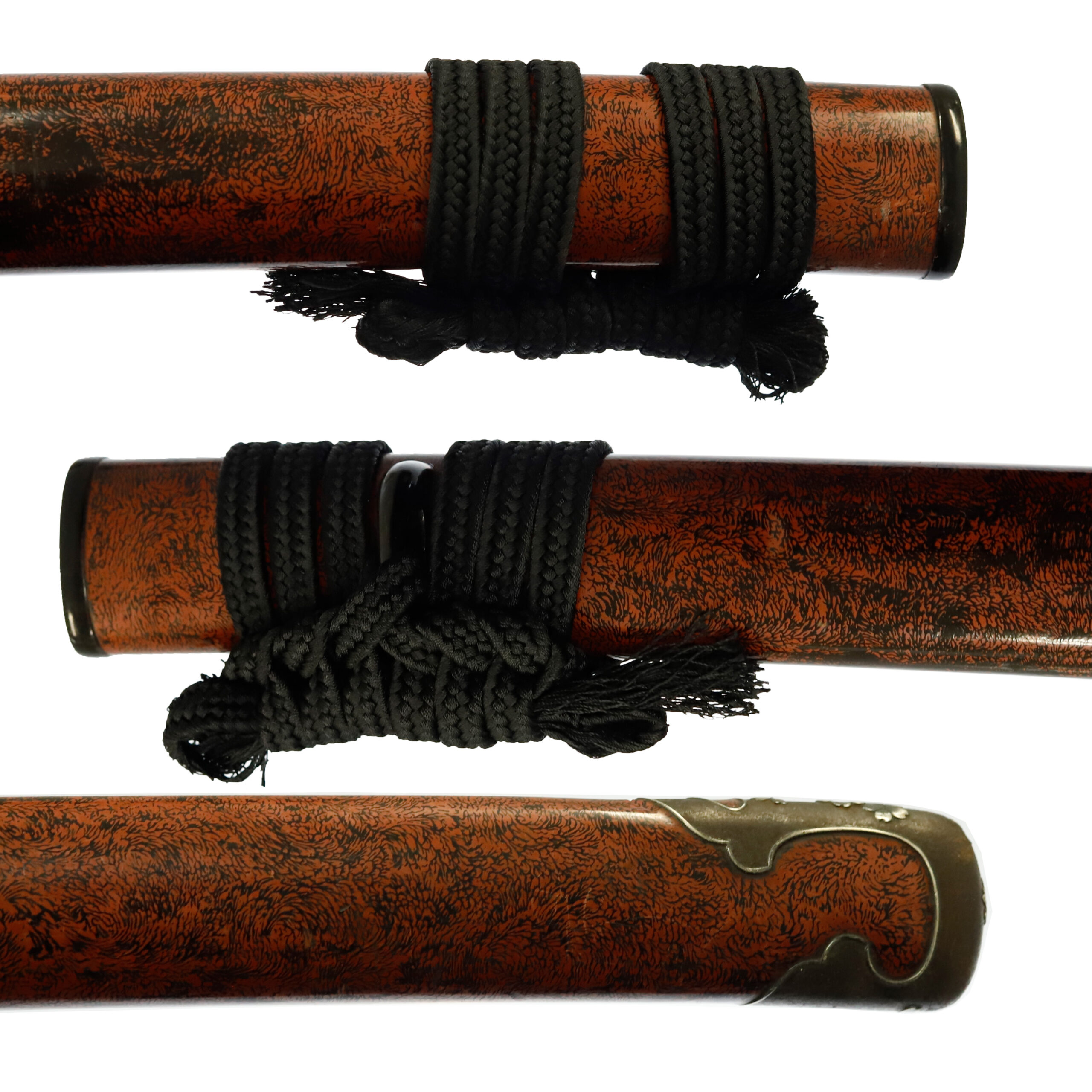
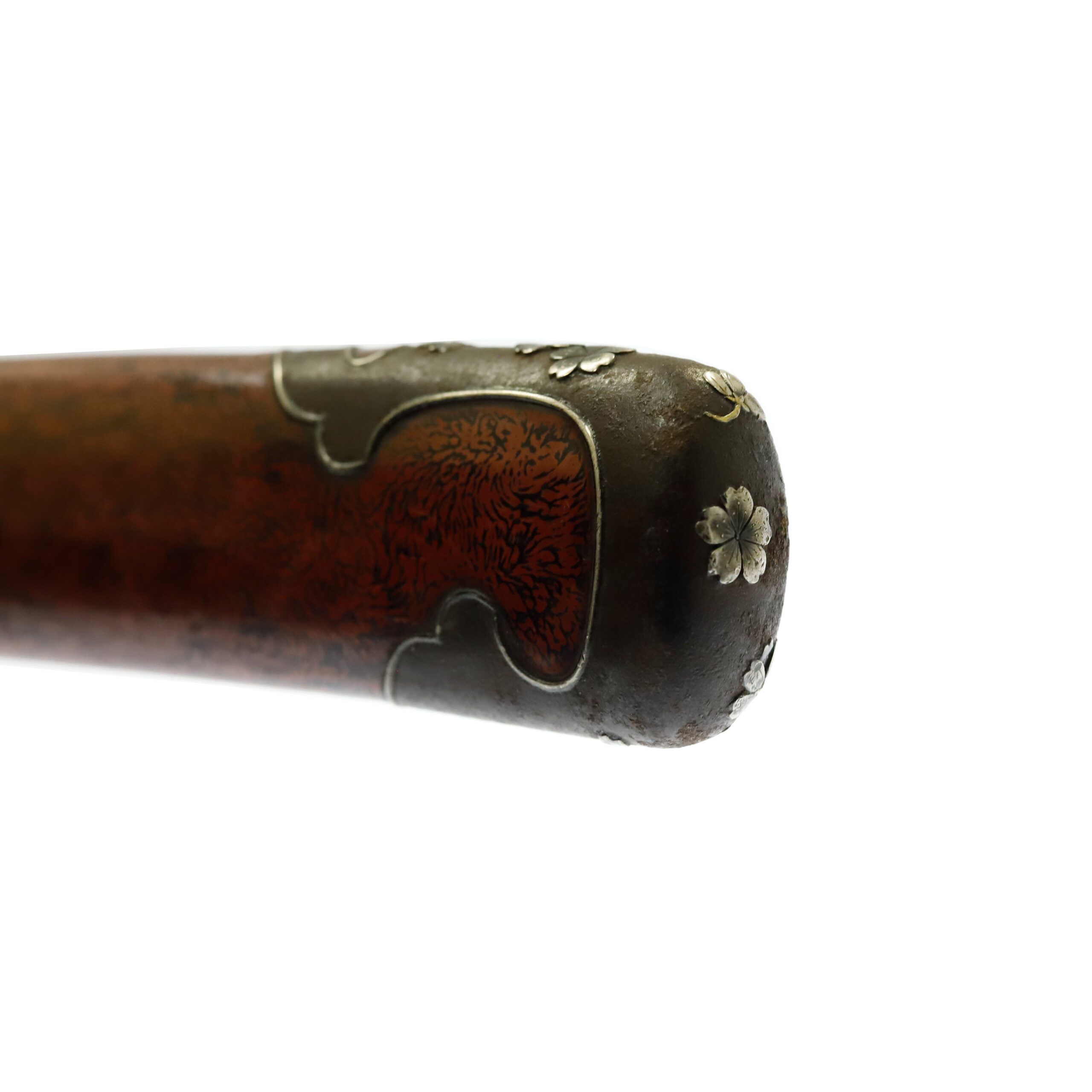
Authentication Paper: NBTHK TOKUBETSU Hozon Certificate for the blade (No. 1002917)
NBTHK, also known as Nihon Bijutsu Touken Hozon Kyokai (the Society for the Preservation of the Japan Art Sword), is one of the oldest Japanese sword appraising organizations in modern-day Japan. They authenticated the blade on Feb 5th in the 27th year of Heisei (2015). They appraised it as Tokubetsu Hozon Touken, the blade especially worth preserving for Japanese society. The purchaser will receive this original certificate as well. We can also translate what is written into English and make a PDF file for your record if you request.

Registration Number: Hyogo 75914
The Board of Education in Hyogo prefecture issued a registration paper for this sword . It is called Jyu Hou Token Rui Tourokusho (銃砲刀剣類登録証). Bunkacho (The Agency for Cultural Affairs) acknowledges a Japanese sword with this paper as a work of art.
The sword needs to be traditionally hand-forged and made of Tamahagane carbon steel to be registered in the system. With this paper, its owner in Japan can legally own an authentic Japanese sword. Based on this registration number, we will apply for its export permit.
This paper will need to be returned to the board of education when the sword is being shipped abroad, but you can receive a copy of it. An English translation of this registration paper is available on request.
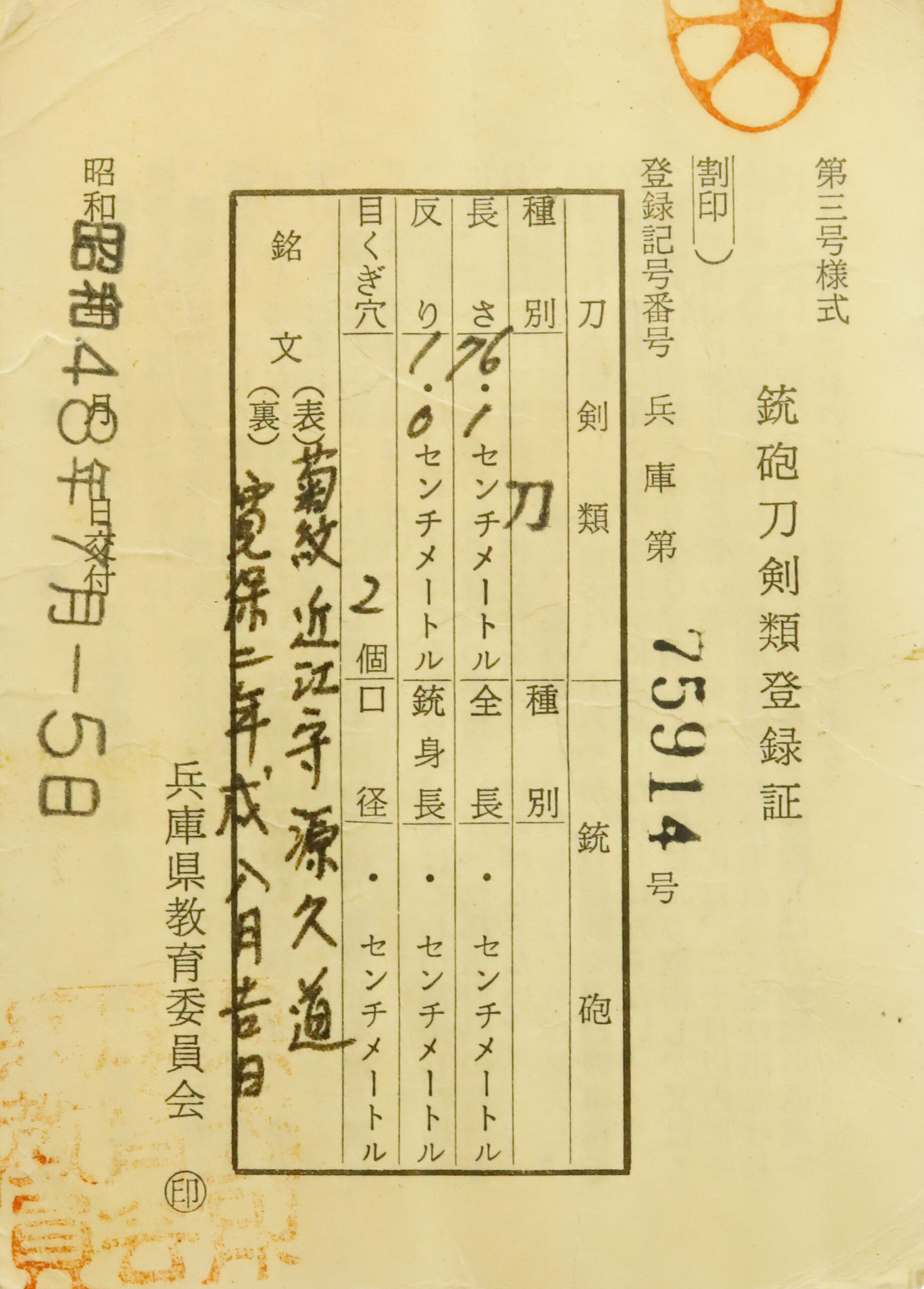
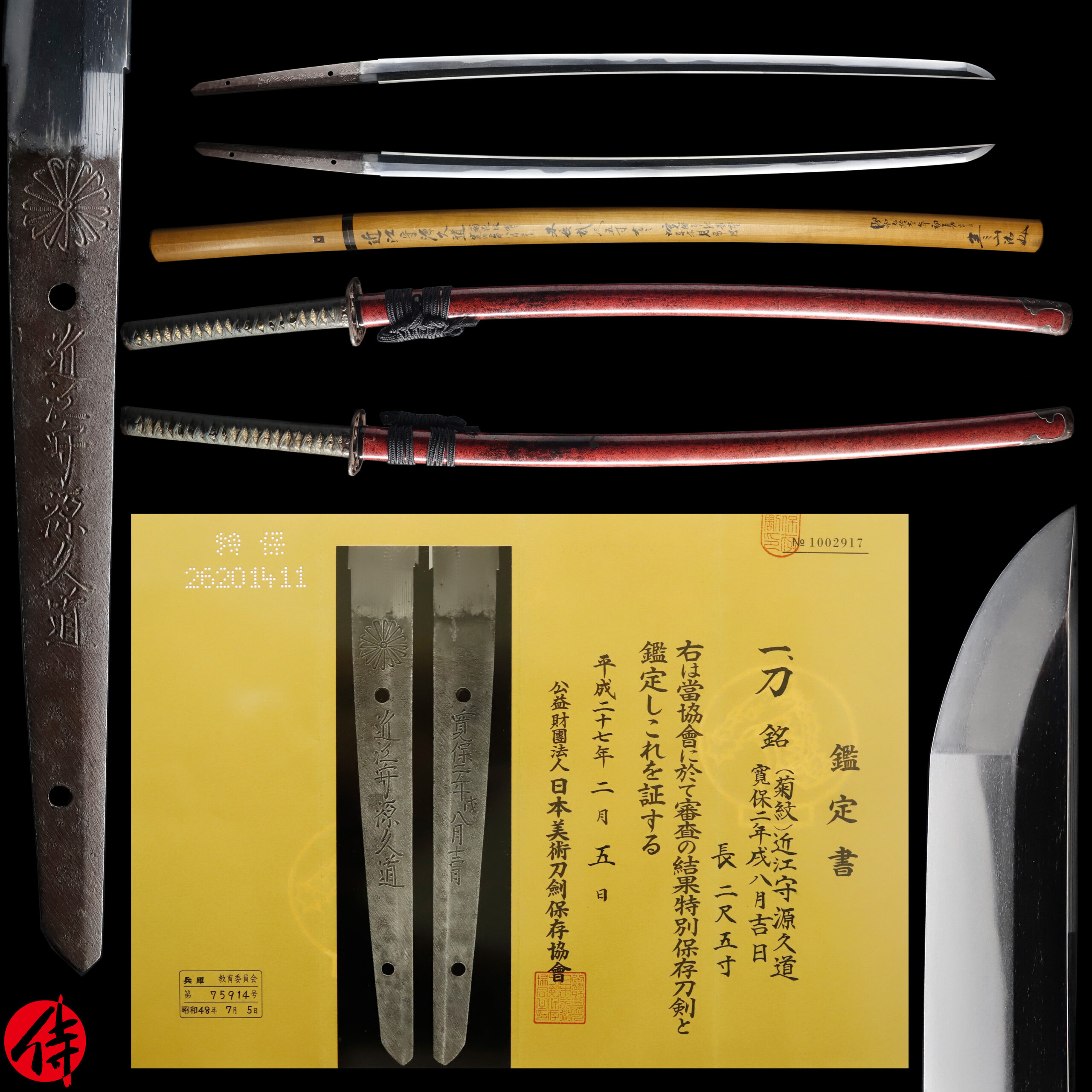
【About us】
Samurai Museum is located in Tokyo, Japan, exhibiting antique artifacts related to the Samurai history. Samurai Museum Shop is the place for those who are interested in Japanese culture and craftsmanship. We deal with antique Samurai swords/armor, traditional crafts made in Japan and so on.
【Japanese Sword& Export Process】
The Japanese swords we deal with are hand-forged edged swords made in Japan. It was made from the traditional carbon steel called TAMAHAGANE(玉鋼). Samurai Museum is familiar with the proper legal procedure for an antique/ authentic Japanese sword to be exported from Japan. We have sent more than 700 Japanese swords for the past few years (~2024) to amazing owners who appreciate its historical value.
Each Japanese sword is registered under the Agency for Cultural Affairs and the Board of Education in Japan. They issue a registration paper for each Japanese sword for its owner in Japan to legally possess it. The Japanese sword with its registration paper means it was traditionally hand-forged in Japan.
To legally export the sword from Japan to other countries, we will have to apply for its permit to the Agency for Cultural Affairs(Bunkacho) and return the original registration paper to the Board of Education. It normally takes around 2-4 weeks to receive this permit after submitting required documents. And we would like you to expect at least 1-1.5 months for your order to arrive at your given address after you ordered. For more detailed info, please click here.
It is allowed for residents in Japan to own authentic Japanese swords without a special license as long as they come with registration papers. Please feel free to contact us if you are a resident of Japan, whether temporarily or permanently. We will also assist you when you leave Japan and need to obtain the export permit.
【Payment Method】
We accept payment through Stripe (Credit card), PayPal, Apple Pay or ChromePay, all of which are secure payment methods. Also, you don’t need to make an account on Stripe for the checkout. If you prefer other payment method, please contact us. After confirming your payment, we will apply for an export permit. You may either pay in JPY, USD, AUD, CAD,EUR CHF or GBP. The price is set in Japanese Yen. Prices in other currencies are automatically calculated based on the latest exchange rate.

* If the amount is above 1 million JPY, Stripe or wire transfer will be the only options for payment.
【Shipping】
We have shipped authentic Japanese swords to the USA, UK, Canada, Mexico, Germany, France, Hong Kong and Australia. If you don’t live in these countries and like to order, please contact us first before making a purchase. We offer Free International Shipping as long as we can send antique Japanese swords by EMS.
We normally ship by EMS(Express Mail Service) provided by Japan Post. We will send you a tracking number for your order as soon as we hand it to the post office. We will put 100 % insurance on the shipping document without any extra charge. Based on the total amount, there might be a duty tax or other fee for you to pay, depending on the countries. We use package cushioning to protect the item and put it in a PVC pipe, which is one of the most secure packages because of its durability.
It will normally takes 5-14 days for the item to arrive at your given address after we dispatch it. Time of delivery is estimated as accurately as possible by the carrier but does not take into account any delays beyond our control such as by inclement weather, post office holiday seasons.
* If you live in Australia and like to purchase an authentic Japanese sword, please click here to know the detail.

【Review】
Here is one of the reviews we received from a customer who purchased an authentic Japanese sword from us. For more reviews, please click here.
“My experience overall with the whole process was wonderful. I had many questions about the history and process to purchase these treasures. All my questions were answered very timely and complete. The staff is very knowledgeable and very well versed if any questions do arise.”
【How to make sure the condition】
Please keep in mind that what you are going to purchase is an antique item. We uploaded high resolution photos for you to check its condition thoroughly. If you like to see more photos with different angles, please feel free to contact us. We will be happy to send them to you so that you can make informed decision. It is essential for us to know that you are happy with your choice of a sword. and we are prepared to use the best of our ability to serve you.
【How To Contact Us】
Please contact us through email, Facebook Messenger or Live Chat if you have any questions. You can find each icon on the right side of the website. Please click one of them to reach us. We will reply to you within 1-2 business days.
【The Art of Nihonto (Japanese Sword)】
Samurai’s history is a profound, eloquent legacy of ancient Japanese warriors in which millions of people worldwide are being fascinated. If you like to find out the art of Nihonto, please click here.
【A Guide to Japanese Sword Maintenance】
After acquiring an genuine Japanese sword, it is also important to know how to take good care of it. Here is the special video for you. Mr. Paul Martin, Japanese sword expert, shows you how to give proper maintenance to your sword. By mastering how to clean the Japanese sword, its aesthetic beauty will last forever.
When you purchase a Japanese sword from us, you can get a Free Japanese sword maintenance kit. It comes with four tools(Choji Oil, Uchiko Whetstone Powder, Peg remover, Oil Applicator). By watching the video instruction above , you can enjoy learning how to maintain your Japanese sword while appreciating it. If you have any difficulty assembling the sword or cleaning the blade, you can feel free to contact us.


MORE ANTIQUE JAPANESE SWORD FOR SALE
SWORDS WITHOUT CERTIFICATES FOR SALE
LEARN JAPANESE SWORD TERMINOLOGY
Thank you for reading all the information on the page. If you have any difficulty choosing the right Japanese sword for you, we will be more than happy to help you find the one that speaks to you the most. Please feel free to contact us.
